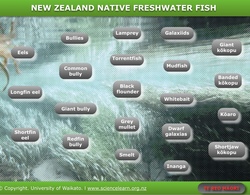Three eel species are present in New Zealand – the shortfin, longfin and Australian longfin (Anguilla reinhardtii) or spotted eel, thought to have arrived of its own accord as recently as 25 years ago.
Eels (tuna) are such an important resource for Māori that, in the past, battles were fought over them. Tuna were caught using woven pots (hīnaki), stream fences (pā tuna), spears (matarau), nets (kōrapa), baited lines (toi), ditches (koumu) or bare hands. Māori have over 100 local names for the three species of eels in New Zealand.
Like some galaxiids, eels also make the arduous journey between the sea and freshwater to complete their life cycle.
Updated science: In this video Erina explains that the leptocephali – eel larvae – 'float' back upstream on the current. Current scientific belief is now that the larvae are not passive drifters but have some swimming ability to get them where they need to go. The nature of science is such, that we are often having to reevaluate our ideas and knowledge.
Transcript
Erina Watene-Rawiri
Taonga species are species that are precious to Māori.
Eels are a taonga species, so Māori have relied on eels for generations.
Eels have quite a complex life cycle. They spend part of their life in the ocean and part in freshwater, so if we start with the adults, they’ll be hanging out in the streams and lakes. And then when they’re ready to go out and spawn, they head down stream en masse and out to the ocean. They swim for a couple of thousand miles out towards Tonga where they spawn, at quite a depth.
The eggs then rise to the surface and hatch, and you have these little tiny eel larvae, which are see-through and they’re leaf-shaped – they’re called leptocephali. The leptocephali float back to New Zealand on the ocean currents, and just before they head back up into the rivers, they metamorphose into what we call glass eels. Glass eels are tiny see-through baby eels, and they swim up the river, and as they continue on up the river, they change colour, they go black. And they turn into what we call elvers, and elvers are just pretty much miniature versions of adult eels. And they stay in freshwater from anywhere between 20 to 60 to 100 years before they become adults, and then they head back out to sea and spawn again. The adults, when they spawn, they die – only the babies come back.
Acknowledgement: © University of Waikato. Please refer to video credits for acknowledgements.


